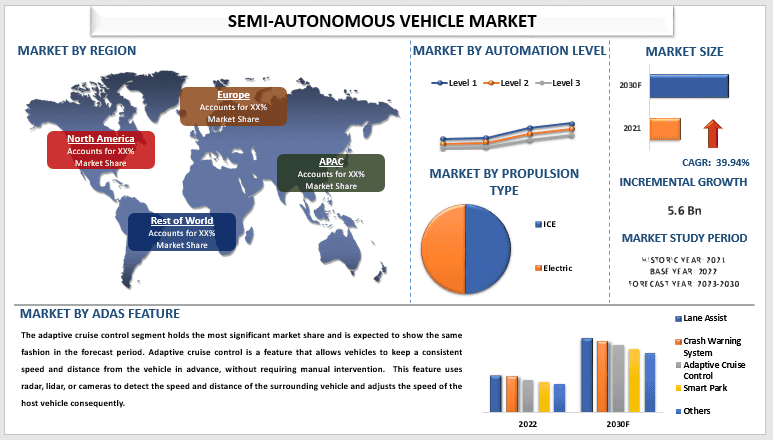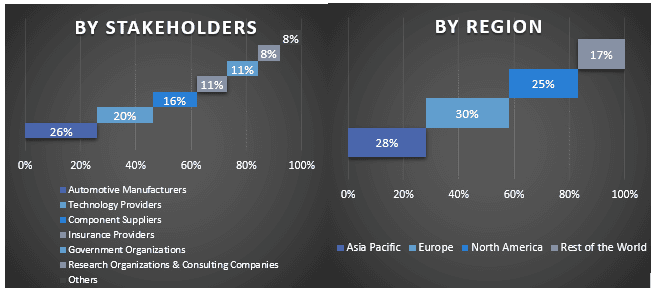- Home
- About Us
- Industry
- Services
- Reading
- Contact Us
Semi-Autonomous Vehicle Market: Current Analysis and Forecast (2023-2030)
Emphasis on Automation Level (Level 1, Level 2, and Level 3); Components (Cameras, LiDAR, Radar, and Others); Propulsion Type (ICE and Electric); ADAS Features (Lane Assist, Crash Warning System, Adaptive Cruise Control, Smart Park, and Others ); and Region/Country

The semi-autonomous vehicle market was valued at 412 Million is expected to grow at a strong CAGR of around 39.94% during the forecast period 2023-2030 owing to the growing demand for fuel efficiency and reduced emissions. As the global automobile industry persists in efforts to lessen its carbon footprint and achieve extra fuel performance, the popularity of semi-autonomous cars has been swiftly growing in recent years. This trend can be attributed to a multitude of factors, which include stringent governmental regulations promoting emissions reduction and sustainable transportation. With the emergence of electric and hybrid vehicles, the emphasis has shifted towards developing cutting-edge technology able to improve fuel efficiency and reduce environmental impact. Semi-autonomous vehicles, which boast advanced driver assistance systems (ADAS) and connected car capabilities, have been deemed a viable option to satisfy these objectives. For instance, in April 2023, the European Parliament and the Council adopted Regulation (EU) amending Regulation to strengthen the CO2 emission performance standards for new passenger cars and new light commercial vehicles in line with the European Union’s increased climate ambition.
In particular, the amendment strengthens the emission targets applied from 2030 and sets a 100% reduction target from 2035 onwards. Moreover, advancements in connectivity and artificial intelligence have enabled semi-autonomous vehicles to optimize fuel consumption and reduce emissions through real-time data analysis and predictive maintenance. For example, Audi’s “Traffic Jam Assist” feature uses machine learning algorithms to analyze traffic patterns and adjust the vehicle’s speed, accordingly, resulting in improved fuel efficiency and reduced emissions. Therefore, the growing demand for fuel efficiency and reduced emissions drives the semi-autonomous vehicle market.
Some of the major players operating in the market include BMW AG, Audi AG, Daimler AG, Ford Motor Company, General Motors, Volkswagen, Mahindra & Mahindra Ltd., BYD Company Ltd., Tesla, Inc., and Hyundai Motor Company. Several M&As along with partnerships have been undertaken by these players to facilitate customers with hi-tech and innovative products/technologies.
Insights Presented in the Report
“Amongst automation level, the level 1 segment leads the market in 2022”
Based on the automation level, the market is divided into level 1, level 2, and level 3. Among these, the level 3 segment is predicted to generate the highest revenue in the forecast period due to its advanced driver assistance features like lane departure warnings, adaptive cruise control, and collision detection. These features are designed and equipped to improve the overall safety of the occupants and other road users. Moreover, Lane Departure Warning systems help alert drivers if they unintentionally drift out of their lane, reducing the risk of collision caused by driver distraction or drowsiness. For instance, Driver fatigue or drowsiness contributed to an estimated 30,000 deaths worldwide in 2022.
“Amongst type, the 2-way valve segment dominated the market in 2022”
Based on components, the market is segmented into cameras, LiDAR, radar, and others. The cameras segment is currently dominating the market in terms of revenue generation and is expected to dominate in the forecast period. This is because cameras can provide high-resolution images and accurate object detection, making them an essential component of semi-autonomous vehicles. Moreover, semi-autonomous vehicles heavily rely on a bunch of sensors and cameras that process the data and make wise decisions about the environment around them. Additionally, with respect to time and economies of scale the price of cameras decreases year-by-year making them affordable to semi-autonomous vehicles, thus the adoption becomes more widespread, further solidifying their position in the market.
Amongst components, the cameras segment dominated the market in 2022”
Based on components, the market is segmented into cameras, LiDAR, radar, and others. The cameras segment is currently dominating the market in terms of revenue generation and is expected to dominate in the forecast period. This is due to the fact that cameras are able to provide high-resolution images and accurate object detection, making them an essential component of semi-autonomous vehicles. Moreover, semi-autonomous vehicles heavily rely on a bunch of sensors and cameras that process the data and make wise decisions about the environment around them. Additionally, with respect to time and economies of scale, the price of cameras decreases year-by-year making them affordable to semi-autonomous vehicles, thus the adoption becomes more widespread, further solidifying their position in the market.
Amongst ADAS features, the adaptive cruise control segment holds the most significant market in 2022.”
Based on ADAS features, the market is divided into lane assist, crash warning system, adaptive cruise control, smart park, and others. The adaptive cruise control segment holds the most significant market share and is expected to show the same fashion in the forecast period. Adaptive cruise control is a feature that allows vehicles to keep a consistent speed and distance from the vehicle in advance, without requiring manual intervention. This feature uses radar, lidar, or cameras to detect the speed and distance of surrounding vehicles and adjusts the speed of the host vehicle consequently. Adaptive cruise control has gained enormous popularity in recent years due to its capability to reduce traffic congestion and enhance protection on the roads. Moreover, implementing adaptive cruise control can lead to reduced fuel consumption and lower insurance premiums, providing tangible economic benefits to users.
“Asia Pacific expedites highest CAGR for the semi-autonomous vehicle market in 2022.”
North American region has dominated the market in the historic year due to the early adoption and strong automotive industry. Moreover, the persistent government financial and regulatory support has geared up the growth of the semi-autonomous vehicle in the region. However, the Asia Pacific is projected to be the fastest-growing region in the forecast period due to several reasons such as rapid urbanization as more and more people are migrating from rural to urban areas the demand for personal mobility has increased, and efficient transportation solutions have increased exponentially in the Asia Pacific region. Semi-autonomous vehicles offer a viable solution to this problem, as they can ease traffic congestion and reduce travel time. Furthermore, governments in the Asia Pacific region are actively promoting the adoption of autonomous and semi-autonomous vehicles via policy reforms and funding initiatives. For instance, in August 2023, China released its first national draft guideline on the use of self-driving vehicles for public transportation. That month, authorities in Wuhan, Hubei province, and Yongchuan district, Chongqing, granted Baidu the first permits issued in China to charge fares for fully driverless ride-hailing services in designated areas.
Semi-Autonomous Vehicle Market Report Coverage

Reasons to buy this report:
- The study includes market sizing and forecasting analysis validated by authenticated key industry experts.
- The report presents a quick review of overall industry performance at one glance.
- The report covers an in-depth analysis of prominent industry peers with a primary focus on key business financials, product portfolios, expansion strategies, and recent developments.
- Detailed examination of drivers, restraints, key trends, and opportunities prevailing in the industry.
- The study comprehensively covers the market across different segments.
- Deep dive regional level analysis of the industry.
Customization Options:
The global semi-autonomous vehicle market can further be customized as per the requirement or any other market segment. Besides this, UMI understands that you may have your own business needs, hence feel free to connect with us to get a report that completely suits your requirements.
Table of Content
Research Methodology for the Semi-Autonomous Vehicle Market Analysis (2023-2030)
Analyzing the historical market, estimating the current market, and forecasting the future market of the global semi-autonomous vehicle market were the three major steps undertaken to create and analyze the adoption of semi-autonomous vehicles in major regions globally. Exhaustive secondary research was conducted to collect the historical market numbers and estimate the current market size. Secondly, to validate these insights, numerous findings and assumptions were taken into consideration. Moreover, exhaustive primary interviews were also conducted, with industry experts across the value chain of the global semi-autonomous vehicle market. Post assumption and validation of market numbers through primary interviews, we employed a top-down/bottom-up approach to forecasting the complete market size. Thereafter, market breakdown and data triangulation methods were adopted to estimate and analyze the market size of segments and sub-segments of the industry pertains to. Detailed methodology is explained below:
Analysis of Historical Market Size
Step 1: In-Depth Study of Secondary Sources:
Detail secondary study was conducted to obtain the historical market size of the semi-autonomous vehicle market through company internal sources such as annual reports & financial statements, performance presentations, press releases, etc., and external sources including journals, news & articles, government publications, competitor publications, sector reports, third-party database, and other credible publications.
Step 2: Market Segmentation:
After obtaining the historical market size of the semi-autonomous vehicle market, we conducted a detailed secondary analysis to gather historical market insights and share for different segments & sub-segments for major regions. Major segments are included in the report as automation level, components, propulsion type, and ADAS features. Further country-level analyses were conducted to evaluate the overall adoption of testing models in that region.
Step 3: Factor Analysis:
After acquiring the historical market size of different segments and sub-segments, we conducted a detailed factor analysis to estimate the current market size of the semi-autonomous vehicle market. Further, we conducted factor analysis using dependent and independent variables such as automation level, components, propulsion type, and ADAS features of the semi-autonomous vehicle market. A thorough analysis was conducted for demand and supply-side scenarios considering top partnerships, mergers and acquisitions, business expansion, and product launches in the semi-autonomous vehicle market sector across the globe.
Current Market Size Estimate & Forecast
Current Market Sizing: Based on actionable insights from the above 3 steps, we arrived at the current market size, key players in the global semi-autonomous vehicle market, and market shares of the segments. All the required percentage shares split and market breakdowns were determined using the above-mentioned secondary approach and were verified through primary interviews.
Estimation & Forecasting: For market estimation and forecast, weights were assigned to different factors including drivers & trends, restraints, and opportunities available for the stakeholders. After analyzing these factors, relevant forecasting techniques i.e., the top-down/bottom-up approach were applied to arrive at the market forecast for 2030 for different segments and sub-segments across the major markets globally. The research methodology adopted to estimate the market size encompasses:
- The industry’s market size, in terms of revenue (USD) and the adoption rate of the semi-autonomous vehicle market across the major markets domestically
- All percentage shares, splits, and breakdowns of market segments and sub-segments
- Key players in the global semi-autonomous vehicle market in terms of products offered. Also, the growth strategies adopted by these players to compete in the fast-growing market.
Market Size and Share Validation
Primary Research: In-depth interviews were conducted with the Key Opinion Leaders (KOLs), including Top Level Executives (CXO/VPs, Sales Head, Marketing Head, Operational Head, Regional Head, Country Head, etc.) across major regions. Primary research findings were then summarized, and statistical analysis was performed to prove the stated hypothesis. Inputs from primary research were consolidated with secondary findings, hence turning information into actionable insights.
Split of Primary Participants in Different Regions

Market Engineering
The data triangulation technique was employed to complete the overall market estimation and to arrive at precise statistical numbers for each segment and sub-segment of the global semi-autonomous vehicle market. data was split into several segments & sub-segments post studying various parameters and trends in the areas of the vehicle type, type, and application in the global semi-autonomous vehicle market.
The main objective of the Semi-Autonomous Vehicle Market Study
The current & future market trends of the global semi-autonomous vehicle market were pinpointed in the study. Investors can gain strategic insights to base their discretion for investments on the qualitative and quantitative analysis performed in the study. Current and future market trends determined the overall attractiveness of the market at a regional level, providing a platform for the industrial participant to exploit the untapped market to benefit from a first-mover advantage. Other quantitative goals of the studies include:
- Analyze the current and forecast market size of the semi-autonomous vehicle market in terms of value (USD). Also, analyze the current and forecast market size of different segments and sub-segments
- Segments in the study include areas of the automation level, components, propulsion type, and ADAS features
- Define and analysis of the regulatory framework for the semi-autonomous vehicle industry
- Analyze the value chain involved with the presence of various intermediaries, along with analyzing customer and competitor behaviors of the industry
- Analyze the current and forecast market size of the semi-autonomous vehicle market for the major region
- Major countries of regions studied in the report include Asia Pacific, Europe, North America, and the Rest of the World
- Company profiles of the semi-autonomous vehicle market and the growth strategies adopted by the market players to sustain in the fast-growing market
Deep dive regional level analysis of the industry
Related Reports
Customers who bought this item also bought










